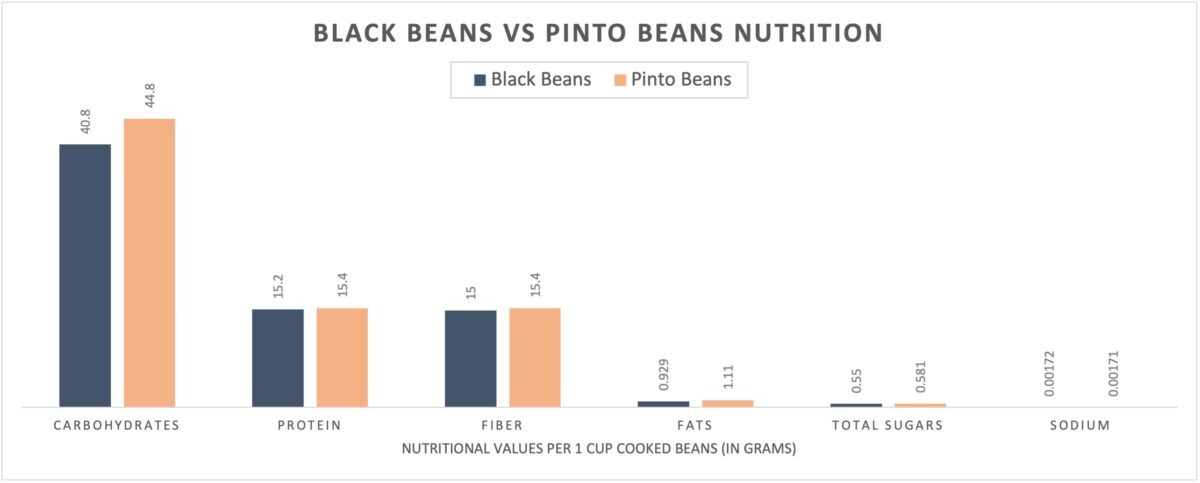
Beans, revered for their myriad health benefits and versatility in cuisine, have long been a staple in diets across the globe. Among the most commonly consumed varieties are black beans and pinto beans. While both options boast impressive nutritional profiles, discerning which bean is healthier requires a comprehensive exploration of their respective attributes. This analysis seeks to elucidate the nutritional nuances of black and pinto beans, offering insights that might transform your culinary choices and enhance your dietary regimen.
To begin with, both black and pinto beans are excellent sources of plant-based protein and fiber. Protein is essential for muscle repair and overall body function, while fiber plays a pivotal role in digestive health and can aid in weight management by promoting a feeling of fullness. However, the protein content varies slightly. A standard serving of black beans contains approximately 15 grams of protein per cooked cup, while pinto beans offer around 14 grams. This marginal difference is negligible, yet those seeking to maximize protein intake may find black beans to be a slightly superior choice.
Next, the fiber content warrants attention. For individuals striving to increase their dietary fiber intake, both beans deliver a hefty dose. Black beans provide roughly 15 grams of fiber per cooked cup, while pinto beans offer about 13 grams. The soluble and insoluble fibers prevalent in these legumes contribute to improved gut health by fostering beneficial bacteria and enhancing regularity. Moreover, fiber-rich diets have been linked with a reduced risk of chronic diseases such as cardiovascular ailments and type 2 diabetes.
In addition to protein and fiber, beans are endowed with an array of essential vitamins and minerals. Black beans are particularly rich in iron and folate, nutrients crucial for oxygen transport in the body and cellular division, respectively. One cup of cooked black beans delivers nearly 20% of the daily recommended intake of iron and about 64% of folate. Conversely, pinto beans also possess considerable nutritional value but are particularly abundant in potassium and magnesium, minerals vital for cardiovascular health and muscle function. A serving of pinto beans can provide approximately 20% of the daily potassium requirement.
Furthermore, it is essential to consider the antioxidant properties intrinsic to these legumes. Black beans, characteristically darker in color, contain higher concentrations of anthocyanins, potent compounds known for their anti-inflammatory and antioxidant effects. This can be a significant factor for individuals focused on overall health and well-being, as antioxidants contribute to the body’s defense against oxidative stress and may mitigate the risk of chronic disease.
When exploring the glycemic index (GI) of these beans, both black beans and pinto beans exhibit low glycemic responses, making them excellent choices for blood sugar management. Foods with low GI values are digested at a slower rate, leading to gradual increases in blood glucose levels. Such properties make both options favorable for individuals with diabetes or those looking to maintain steady energy levels throughout the day.
In terms of culinary versatility, both varieties have unique flavors and textures that make them appealing to various palates. Black beans possess a slightly earthy flavor and creamy texture, pairing seamlessly with spices and contributing depth to dishes such as tacos, burritos, and salads. Pinto beans, on the other hand, deliver a more robust, beany flavor and are often utilized in traditional dishes such as refried beans and chili. The choice between the two may ultimately depend on personal preference, as both can be incorporated into a balanced diet.
However, it is important to recognize potential drawbacks. Some individuals may experience digestive discomfort when consuming beans due to their oligosaccharide content, a type of carbohydrate that can cause bloating and gas. To mitigate these effects, soaking and cooking beans thoroughly can aid in the breakdown of these compounds, rendering them more digestible. Additionally, if you are sensitive to sodium, consider opting for low-sodium canned varieties or cooking dried beans from scratch to maintain control over salt intake.
In summary, the question of which beans are healthier—black or pinto—does not have a definitive answer, as both varieties provide an abundance of nutritional benefits. Black beans are slightly more advantageous in terms of protein, fiber, and antioxidant content, while pinto beans excel in providing potassium and magnesium. The decision may ultimately hinge on individual health goals, culinary preferences, and specific dietary needs.
Incorporating both black and pinto beans into one’s diet can maximize nutrient intake, catering to a diverse range of tastes and dishes. As we continue to explore plant-based diets and their implications for health, beans stand out as nutritional powerhouses deserving of pride of place on our plates. So the next time you ponder which beans to choose, remember that variety not only enriches your meals but also enhances your health—an exciting perspective worth embracing.
